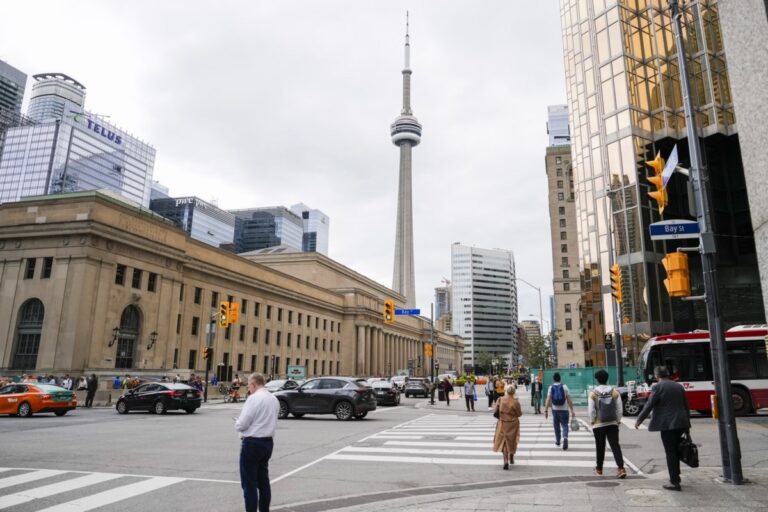Tourists injected billions of dollars into Toronto’s economy last year, but visitation has yet to return to pre-pandemic levels amid signs of slowing growth, according to a new study.
About 26.5 million tourists are expected to visit in 2023 and spend $8.4 billion, mostly on hotels, restaurants and transportation, according to a Tourism Economics report.
But tourist numbers did not reach the record high of 28 million visitors to Toronto in 2019, according to Destination Toronto, the tourism group that commissioned the study.
Last year, 88% of visitors were Canadian, but about 7% were from the United States and 4.5% were from overseas, the latter two proportions being higher before the pandemic.
Spending in 2023 is slightly above pre-pandemic levels, but much of that is due to inflation, said Tariq Khan, the report’s author.
Growth also appears to be stalling: Destination Toronto CEO Andrew Weir said hotel bookings were down slightly in May compared to a year ago, while July and August are on pace to be 1 to 2 per cent slower than the same period last year.
The statistics suggest a possible decline in tourism this summer, but could also reflect a shorter booking window with consumers increasingly booking last-minute trips, he said.
“The recovery is far from complete and it’s uneven,” Weir said in an interview.
“Revenge travel has been strong for a while,” he said, referring to the surge in tourism following two years of pent-up demand due to the COVID-19 pandemic. “Growth is coming back, but it’s slowing.”
But the industry is hoping that at least one spectacle this year will usher in a new era.
“Taylor Swift,” Weir said.
The pop superstar is coming to New York in November for a six-night performance at the Rogers Centre. Hotel bookings for that month are usually solid, but as of early June, they were up about 300 percent from last year, he said. “Why do you think that is?”
Taylor Swift’s influence may be too much for some downtowns to bear.
“We’re already working hard on the infrastructure for that,” said Toronto’s budget director, Councillor Shelley Carroll. “If the venue was there, it could upend the central business district.”
Carroll noted that additional resources, for example emergency services, would be needed to deal with the crowds “as hotels fill up.”
Even a large number of Swifties may not be able to counter the impact of rising inflation and interest rates on tourism.
“Household budgets are under pressure which is leading to a decline in discretionary spending, including tourism,” Weir said.
The numbers have also been hit by a steep drop in visitors from China, Toronto’s largest international tourism market, which saw more than 300,000 visitors in 2019. The drop of more than three-quarters comes after China decided to remove Canada from the list of countries approved for group travel last summer, even as the United States, Britain, Australia and others were added to the list.
“This legislation will allow organisations to meet and businesses to travel,” Weir said, noting that Canada is not an approved destination due to “diplomatic issues”.
“They were high-yield travelers,” he added. “If you’re flying 12 hours, you’re staying longer and you’re doing more when you get there.”
Still, leisure tourism is recovering faster than corporate tourism, with a slow recovery in trade conferences and business travel being a big part of tourism’s slump this year.
Destination Toronto hosted 71 major conferences and events last year, far fewer than the more than 100 gatherings in 2018. The 2023 event drew 290,000 businesspeople, many of them tourists, spending about $400 million, which Weir said speaks to the size of conventions’ economic contribution. But the figure pales in comparison to the $800 million spent six years ago.
“Some of the major conferences have not yet fully resumed,” he said.
Canada has gradually relaxed health and travel restrictions in the years since the pandemic began, but that may have also led to a decline in bookings for large events, as large conventions are booked up to seven years in advance.
“A lot of the meetings that were going to happen in ’23, ’24, ’25, ’26 were booked for 2021. And in 2021, U.S. meeting planners weren’t choosing Canada because the border was closed,” Weir said.
Meanwhile, individual business travelers and small corporate groups are increasingly opting for video calls rather than costly and time-consuming on-site visits.
“That has changed forever,” Weir said.
According to the study, the tourism industry directly created about 47,300 jobs in Toronto last year and indirectly supported about 20,000 jobs, making it increasingly important for businesses to develop new markets and expand tourism.
“If you’re only selling within the Toronto or Ontario economic region, you’re not growing, you’re just moving money around within the economic region,” Weir said.
The Bank of Canada cut its key interest rate on Wednesday for the first time in more than four years, which Carroll said should start to ease financial pressures on would-be tourists.
She also reiterated Toronto city council’s call on the province and Ottawa to cut the harmonized sales tax and put it towards services that support the local economy, including tourism.
“For every $100 people spend on food and hotels, $13 gets split almost evenly between the federal and state governments, and we don’t get a dollar of it,” Carroll said, noting that big cities like New York City and Chicago have sales taxes.
“We’re asking for 1 cent on the dollar” — for example, for a $100 restaurant bill, that would mean $1 going back to the city.
“That little share is going to make a big difference,” the councilman said. “If we really want to go supernova and become a super city, a super host, that’s the one thing we’re missing.”
This report by The Canadian Press was first published June 6, 2024.
Christopher Reynolds, The Canadian Press

